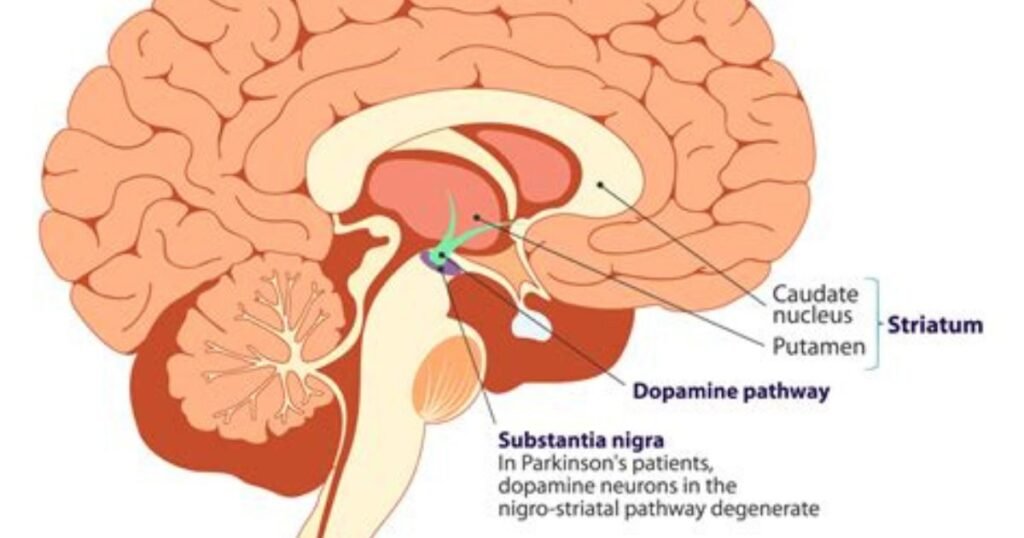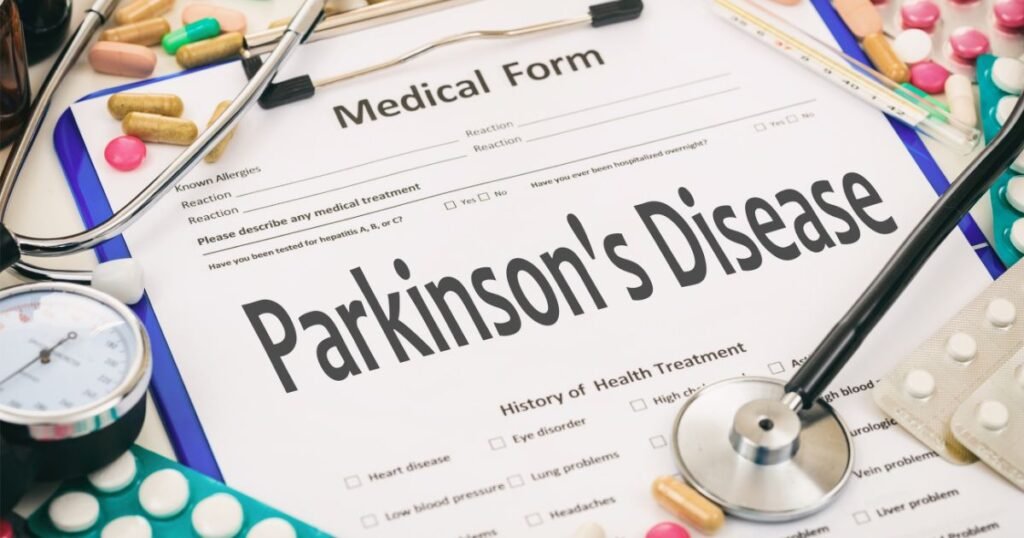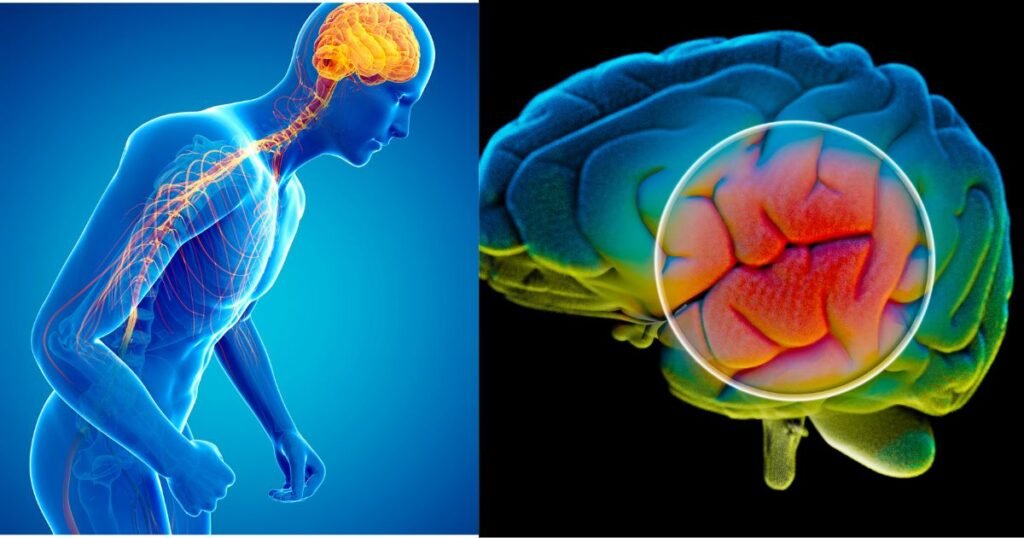Introduction
Parkinson disease is a neurodegenerative disorder that results in involuntry and uncontrolled movements i.e shaking, stiffness, and issues with balance and coordination. It is the second most common neurodegenerative disorder after Alzheimer’s disease and it is estimated to affect about 1% of the population over the age of 60.
Causes of Parkinson’s disease
The cause of Parkinson disease is not fully understood, but it is believed to be a combination of genetic and environmental factors. It is characterized by the loss of dopamine-producing cells in the brain, which leads to a reduction in dopamine levels. Dopamine is a chemical messenger that is responsible for transmitting signals in the brain that control movement and coordination.
Despite much investigation, scientists are still not sure about the causative factors which particularly triggers the death dopamine producing cells. Dopamine producing cells are located in the particular region of the brain which is known as substantia nigra region.
Read More: Counter Antibiotics

Dopamine performs a crucial function, for example, When you desire to move a particular portion of your body, it works as a messenger to let another part of your brain know.
Dopamine level decreases when the cells in the brain that produce dopamine begin to die. When it falls too low, patients loose their voluntry actions and experience Parkinson’s symptoms.
One of the most promising caustive might be an age: Though the common age for the first onset is after 60, yet 5-10% population experience before the age of 50. While studies have shown that early age onset of parkinson disease are mostly, but not always, inherited but there are still some forms of disorder which are linked to the variations in the transcription and the translation of the DNA.
Symptoms of Parkinson’s Disease
Parkinson’s disease symptoms and progression rates vary from person to person. At the earlier stages, symptoms are quite subtle and occur gradually. For instance, people may present with the slight tremors and face difficulties while trying to get up from a chair. They could realize the significant changes in their voices as they start speaking too softly and slowly alongwit the noticeable changes in their handwriting as it becomes sluggish, cramped, or undersized. The first people to notice changes in someone with early Parkinson’s disease may be friends or family members. They could notice that the person’s face is lifeless and expressionless or that one arm or leg is not being moved regularly.
Symptoms of Parkinson’s disease typically develop gradually and can include tremors, stiffness, and difficulty with movement and coordination. As the disease progresses, patients may also experience difficulty with
Speech
Swallowing, and balance. Depression, anxiety, and other mood disorders are also common in Parkinson’s disease patients.

There is no cure for Parkinson’s disease, but medications can be used to manage symptoms. The most commonly used medications are levodopa and dopamine agonists, which help to increase dopamine levels in the brain. Surgery, such as deep brain stimulation, may also be an option for some patients.
Physical therapy and occupational therapy can also be helpful for Parkinson’s disease patients. These therapies can help to improve mobility, balance, and coordination, and can also help to prevent falls.
Research into Parkinson’s disease is ongoing, and scientists are working to better understand the causes of the disease and to develop new treatments. Studies have focused on the genetic and environmental factors that may contribute to the development of Parkinson’s disease, as well as on the ways in which dopamine levels can be increased in the brain.
Living with Parkinson’s disease can be challenging, but there are many resources available to help patients and their families. Support groups, rehabilitation programs, and other resources can provide patients with the support and information they need to manage the disease.
In conclusion, Parkinson’s disease is a degenerative disorder of the nervous system that affects movement. It is caused by the loss of dopamine-producing cells in the brain, which leads to a reduction in dopamine levels. While there is no cure for Parkinson’s disease, medications, surgery, and physical therapy can help to manage symptoms. Research is ongoing to better understand the causes of the disease and to develop new treatments.

Read More: parkinson’s disease
It is important to seek medical help as soon as possible if you think you may have Parkinson’s disease, as early diagnosis and treatment can help to slow the progression of the disease and improve quality of life.
Hillary Clinton has Parkinson’s Disease
medical diagnosis indicating that Hillary Clinton has Parkinson’s Disease. It is important to refrain from speculating about a person’s health without evidence or confirmation from a reputable source. However, it is crucial to note that Parkinson’s is a degenerative disorder of the nervous system, affecting movement, that often manifests in tremors, stiffness, and difficulty with walking, balance, and coordination.
It is typically diagnosed in people over the age of 60, but can also occur earlier. This information is general and not specifically related to Mrs. Clinton. Should there be any changes to her health status, one can expect them to be communicated through official channels.
FAQs About Parkinson’s Disease
How Parkinson’s disease is caused?
The substantia nigra’s dopaminergic neurons are dying; a part of the brain crucial for movement and coordination is the primary cause of Parkinson’s disease, a neurodegenerative condition. The condition is connected to a mix of genetic and environmental variables, including exposure to certain chemicals or possessing certain congenital abnormalities, even if the actual etiology is yet unclear. It is important to note that while these factors can increase the risk, they don’t always cause the disease directly.
What are the five stages of Parkinson’s disease?
Parkinson’s disease typically progresses through five stages:
Stage 1: Symptoms at this stage are usually mild and may include slight tremors or changes in body posture, but they typically don’t interfere with daily activities.
Stage 2: Symptoms become more noticeable and may include stiffness and difficulties with facial expressions. Daily tasks may start to become more challenging.
Stage 3: This is often considered the mid-point in the progression. Balance becomes a concern, and physical movements slow down, affecting daily activities.
Stage 4: Symptoms are severe and limiting. Standing without assistance is still possible, but movement may require a walker or other aid. At this point, the person with Parkinson’s cannot live alone.
Stage 5: This is the most advanced and debilitating stage. It often includes a loss of physical independence, cognitive impairments, and possibly hallucinations or delusions.
Is Parkinson’s a serious disease?
Parkinson’s disease is a serious disease that significantly impacts the quality of life, particularly in its advanced stages. Its effects extend beyond physical symptoms to mental and emotional health. People with Parkinson’s may experience mood disorders such as depression and anxiety, cognitive changes, sleep problems, and difficulties with swallowing and speech.
What is Parkinson’s Behaviour?
The behavioral aspects of Parkinson’s can be challenging to manage. Individuals may show apathy, reduced motivation, or social withdrawal. Some may experience hallucinations or delusions, and others may exhibit impulsive or compulsive behaviors.
Is Parkinson’s painful?
While some people with Parkinson’s experience pain, it’s not a universal symptom. When it occurs, it may be muscular, neuropathic, or dystonic (abnormal muscle tension). It can result from the rigidity and immobility caused by the disease.
How is Parkinson’s diagnosed?
Diagnosing Parkinson’s can be challenging since there’s no definitive test. It is largely based on a detailed medical history, a neurological examination, and observing the patient’s symptoms. Doctors sometimes use imaging tests like a DAT scan to assess the dopamine system, but this isn’t a standard diagnostic tool.
What is the best treatment for Parkinson’s disease?
Treatment for Parkinson’s disease aims to manage symptoms. Medication, like Levodopa, dopamine agonists, or MAO-B inhibitors, is commonly used to increase or substitute the dopamine in the brain. Non-drug approaches like physiotherapy, occupational therapy, and speech therapy can also help manage symptoms. Deep Brain Stimulation (DBS) is an option for some patients with advanced Parkinson’s who no longer respond optimally to medications.
Can Parkinson’s be prevented?
Prevention of Parkinson’s is an active area of research, but there’s currently no surefire way to prevent the disease. However, leading a healthy lifestyle—exercising regularly, eating a balanced diet, avoiding exposure to environmental toxins, and maintaining good overall health—can potentially reduce the risk.






